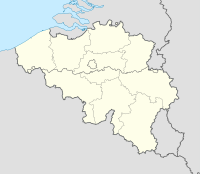First Battle of Ypres
| First Battle of Ypres | |||||||
|---|---|---|---|---|---|---|---|
| Part of the Western Front of World War I | |||||||
 Positions of the Allied and German armies, 19 October 1914 |
|||||||
|
|||||||
| Belligerents | |||||||
|
|
|
||||||
| Commanders and leaders | |||||||
|
|
|
||||||
| Strength | |||||||
| Belgian: c. 247,000 French: 3,989,103 British: 163,897 Total: 4,400,000 |
5,400,000 | ||||||
| Casualties and losses | |||||||
| Belgian: 21,562 French: 50,000–85,000 British: 7,960 killed 29,563 wounded 17,873 missing 2,128 unknown cause Total: 58,155 |
8,050 killed 29,170 wounded 10,545 missing Total: 46,765 |
||||||
| 134,315 German casualties in Belgium and northern France, 15 October – 24 November | |||||||
|
|
|||||||
The First Battle of Ypres (French: Première Bataille des Flandres German: Erste Flandernschlacht, 19 October – 22 November) was a battle of the First World War, fought on the Western Front around Ypres, in West Flanders, Belgium, during October and November 1914. The battle was part of the First Battle of Flanders, in which German, French and Belgian armies and the British Expeditionary Force (BEF) fought from Arras in France to Nieuport on the Belgian coast, from 10 October to mid-November. The battles at Ypres began at the end of the Race to the Sea, reciprocal attempts by the German and Franco-British armies to advance past the northern flank of their opponents. North of Ypres, the fighting continued in the Battle of the Yser (16–31 October), fought between the German 4th Army and the Belgian army and French marines.
The fighting has been divided into five stages, an encounter battle from 19–21 October, the Battle of Langemarck from 21–24 October, the battles at La Bassée and Armentières to 2 November, coincident with more Allied attacks at Ypres and the Battle of Gheluvelt (29–31 October), a fourth phase with the last big German offensive which culminated at the Battle of Nonne Bosschen on 11 November then local operations, which faded out in late November. Brigadier-General J. E. Edmonds, an official historian, wrote in the British History of the Great War, wrote that the II Corps battle at La Bassée could be taken as separate but that the battles from Armentières to Messines and Ypres, were better understood as a battle in two parts, an offensive by III Corps and the Cavalry Corps from 12–18 October), against which the Germans retired and an offensive by the German 6th Army and 4th Army from (19 October – 2 November), which from 30 October, took place mainly north of the Lys, when the battles of Armentières and Messines merged with the Battles of Ypres.
...
Wikipedia

